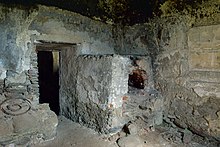Rear loading furnace
The rear loading furnace is a furnace that is not fired in the room in which it is installed, but in an adjoining room.
This operating mode developed from the 15th century out of the need to keep the living space warm and smoke-free. Since the smoke outlet used to be through a hole in the roof, the entire house was streaked with smoke and had to be ventilated constantly. As recently as 1945, so-called smoke houses owned by small farmers and houselands did not have a chimney. The installation of a chimney took almost two centuries until the turn of the century around 1900 to establish itself. Chimneys that protruded over the roof were not legally required until the 19th century.
Nowadays, only tiled stoves are usually built as rear loading stoves . In the past centuries it was either brick, tile or clay ovens, and from the 16th century iron plate ovens were also partly designed as a breech-loader.

history
The Bohlenstube in Jena from 1430 is one of the oldest preserved rooms. Here was a so-called rear-loading stove that was heated from the house, but whose smoke was vented into the house. The living room was the only smoke-free room in the house.
According to an Italian source from 1468, the room air in German rooms was compared with the "exhalations of the Florentine state prison".

The doctor Hippolytus Guaroninius, on the other hand, praised the fact that the high-minded Teutsch Nation invented such a way and means that no wood, steam, smoke or smell, it is good or bad, harms people, yes not at all, but people then still the good and The fire is pleasant and can be enjoyed happily, namely the oven, its door, the heytz or fire hole in the cake, and the smoke clouded by the comb, but the oven heats up and the whole room is endowed with similar warmth, and the people So be protected from the rough and harsh cold. Hippolytus Guarinonius also wrote of the "rolling chimneys and their combers": whether they laugh at the German rooms, but once they come in, nobody can bring them from the stove or out of the room ....
German immigrants in the 18th century took their Plattenöfen to Pennsylvania with (English: closed stoves - closed furnaces, or five-plate stoves - Five plate Oven ). The English-born Americans were suspicious of these German stoves, they feared poor ventilation of the rooms or that the residents might forget to stoke the fire if it was not visible. Although the Mennonite and Amish breech-loading ovens were efficient and fuel-efficient, they were largely rejected by the English because they loved open fires.
Individual evidence
- ↑ Hans-Werner Goetz: Life in the Middle Ages: from the 7th to the 13th century . CH Beck, 1994, ISBN 978-3-406-37970-3 ( google.de [accessed on March 18, 2018]).
- ↑ From the long way of the chimney to our farmhouse. Retrieved March 18, 2018 .
- ↑ Mila Schrader: Cast iron ovens and cookers: history, technology, fascination - a historical review . elsewhere Verlag GmbH, 2001.
- ↑ a b Matthias Henke: The tiled stove - an object of living culture in transition . Ed .: Georg-August-Universität zu Göttingen. 1999.
- ↑ German Iron Furnace Museum - Collection by furnace type. Retrieved March 18, 2018 .
- ↑ Folklore Museum - Collection highlights from the collections - tiled stove, so-called figure stove, known as "oven farmer" or "Annamirl" ÖMV / 35.876. Retrieved March 18, 2018 .
- ↑ Historical plank room. Retrieved March 18, 2018 .
- ↑ Hippolytus Guarinonius: Hippolyti Guarinonii Die Grewel the desolation of the human race: In seven different books ... divided . Angermayr, 1610 ( google.de [accessed on March 18, 2018]).
- ^ Priscilla J. Brewer: From Fireplace to Cookstove: Technology and the Domestic Ideal in America . Syracuse University Press, 2000, ISBN 978-0-8156-0650-5 ( google.de [accessed April 3, 2018]).
- ^ Architecture and Artifacts of the Pennsylvania Germans: Constructing Identity in Early America . Penn State Press, ISBN 0-271-04743-7 ( google.de [accessed April 3, 2018]).
- ^ Jan Stievermann, Oliver Scheiding: A Peculiar Mixture: German-Language Cultures and Identities in Eighteenth-Century North America . Penn State Press, 2013, ISBN 978-0-271-06301-0 ( google.de [accessed April 3, 2018]).
